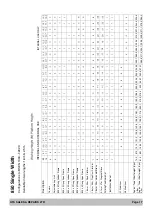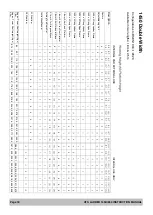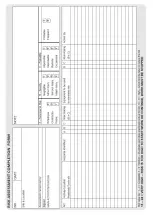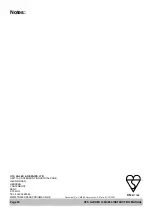
Page 5
UTS SALES & REPAIRS LTD
•
User training courses cannot be a substitute for instruction manuals but only complement them.
•
Only the original UTS components specified in the manual shall be used.
•
Mobile access and working towers designed in accordance with BS EN 1004
-
1:2020 are not anchor points for
personal fall arrest equipment.
•
Working is only permitted on a platform with a complete side protection including guardrails and toe boards.
•
Mobile access and working towers are not designed to be used as edge protection.
STABILISERS & BALLAST
Stabilisers or outriggers and ballast shall always be fitted when specified. When using the MAT externally stabilisers
must be fitted. Should ballast be required, a platform should be positioned on the lowest rung and the weights should
be firmly attached to it and evenly distributed. For advice on ballast contact your supplier.
LIFTING OF EQUIPMENT
Tools and other equipment should be hauled up by a person on the platform using rope or similar, through the
trapdoor of the platform or within the tower footprint.
Please see footprint guide on page 16.
Safe working loads of platform and tower not to be exceeded.
MOVING THE TOWER AND LEAVING IT UNATTENDED
•
Adjust the stabilisers to provide ground clearance.
•
Unlock the castor wheels.
•
Move with manual force only, and only from the base.
•
Beware of (overhead) obstructions –
live wires, hanging apparatus or other objects.
•
Do not move with people or material on the tower.
•
Do not move the assembled MAT if wind speeds exceed a moderate breeze. Relock the castors and readjust
the stabilisers once in the new position.
•
When moving the tower over uneven or sloping ground remove all tools.
•
Do not move the assembled tower if over 4 meters high.
•
Recheck that the MAT is vertical or needs readjustment of legs before ascending. (Using spirit level)
•
Mobile access and working towers shall only be moved on a flat and solid ground without obstacles and not on
a slope of more than 10mm/1m
It is recommended that towers should be tied to a solid structure, when left unattended.
TIES
When ties are required, they should be in accordance with table 17 of BS 5973:1990 and table 24 of BS 5975:1982.
Always tie to a solid structure.
The tie frequency should be at 4 meter intervals or less vertically.
FITTING TOE
-
BOARDS
1 piece folding toe board
, fold out over platform making sure location angle rests fits securely on side of platform.
LIFTING OF INDIVIDUAL TOWER COMPONENTS
Raising and lowering components, tools and/or materials by rope should be conducted within the tower base (i.e.
within the area bounded by the stabilisers). Ensure that the safe working load of the supporting decks and the tower
structure is not exceeded.
Check for environmental changes before every use. (ie: all weather conditions) Refer to next page for wind effects.
Содержание 1450/850
Страница 2: ...UTS LADDER 1450 850 INSTRUCTION MANUAL Page 2...
Страница 19: ......




















